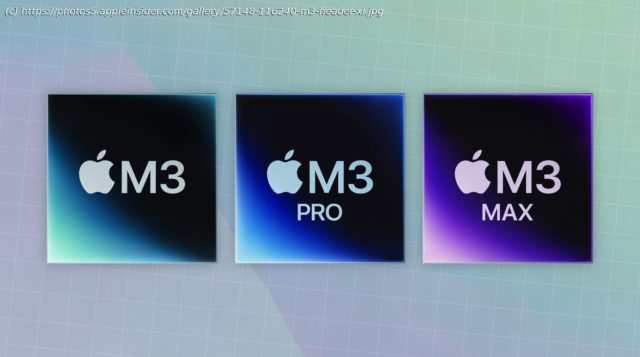Apple’s introduction of M3 didn’t just launch one new chip, but a trio instead. Here are the differences between the M3, the M3 Pro, and the M3 Max.
Apple’s introduction of M3 didn’t just launch one new chip, but a trio instead. Here are the differences between the M3, the M3 Pro, and the M3 Max.
The „Scary Fast“ Apple Event introduced new MacBook Pro and 24-inch iMac models, as well as the launch of a new chip generation. After M1 and M2, Apple has moved on to the M3 generation of Apple Silicon.
However, rather than the usual launch of the entry-level M3 on its own, Apple instead decided to bring out three chips within the range. The M3 was joined by the M3 Pro and the M3 Max, chip variants that typically arrive later in the generation.
As is typical for Apple, it declared the M3 collection to be faster than its predecessors, with additional features introduced as part of the redesign. All of these are made using a 3-nanometer process that enables a more densely-packed chip, as well as benefits in power usage and other efficiencies.
Here’s how the trio of M3 chips differ from each other in the range.
SpecificationsM3 vs M3 Pro vs M3 Max – CPU
The core of the chip, the central processing unit handles the main workload. It is an essential component, and while they are basically made the same way, there are variations in how they function.
This is chiefly down to the amount of cores that each uses, and how those cores are set up, but there are other differences as well to bear in mind. Elements such as memory bandwidth can help bump up performance, for example.
The entry-level M3 has eight CPU cores in total, with an even split between performance cores and efficiency cores. The performance cores can handle tough tasks quickly, while the efficiency cores provide less computing grunt at a typically lower clock speed, but also in a far more power-efficient way than the performance cores.
The M3 Pro goes a stage further, in two forms. The 11-core version has five performance and six efficiency cores, while the 12-core has six performance and six efficiency cores.
This is a departure from the M2 Pro, which had four efficiency cores and either six or eight performance cores. This does mean there are proportionately fewer performance cores to use in the M3 Pro versus efficiency.
This is a philosophical difference versus what it did with M1 Pro and M2 Pro. We theorize that this is related to maximizing the battery life in the M3 Pro, instead of delivering maximum performance — which is what the M3 Max is for.
The M3 Max has the highest core counts, with 14-core and 16-core options available. However, instead of an even split as the other two offer, Apple instead leans the CPU towards performance.
As such, the M3 Max has four efficiency cores, and a choice of 10 or 12 performance cores, depending on the variant.
These core counts also play into the physical size of the chips, with the M3 being the physically smallest and M3 Max the largest.
In terms of transistors used for the entire chip, the M3 has 25 billion, while the M3 Pro uses 37 billion, and the M3 Max employs a mammoth 92 billion transistors. For reference, the M2 generation uses 25 billion, 40 billion, and 67 billion respectively.
When it comes to what performance users will get, Apple generalizes the performance cores as being about 15% faster than the M2 generation and 30% faster than M1. The efficiency cores in M3 are characterized as 30% faster than M2, and 50% faster than M1.
One other major area is memory, but while we will discuss capacity later, it’s pertinent to raise memory bandwidth here. Since accessing the Unified Memory at speed is crucial to performance, the higher the speed is generally better for processing.






